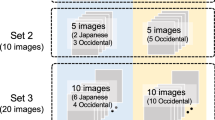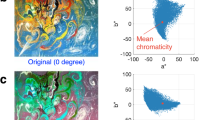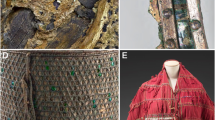Abstract
In insects and other animals, interference colours usually serve as conspicuous visual signals1–4. The colours of tiger beetles also originate by interference of multiple reflections5,6, yet many species exhibit dorsal colorations that appear pigmentary and inconspicuous (cryptic) against soil backgrounds. These dull colours, however, are actually additive mixtures of different interference colours that blend when viewed with the naked eye. This same principle of partitive mixing is used in colour television, printing and the pointillist painting style of neo-impressionist artists7. We report here on the first demonstration of interference colours mixing partitively to produce animal camouflage.
This is a preview of subscription content, access via your institution
Access options
Subscribe to this journal
Receive 51 print issues and online access
$199.00 per year
only $3.90 per issue
Buy this article
- Purchase on Springer Link
- Instant access to full article PDF
Prices may be subject to local taxes which are calculated during checkout
Similar content being viewed by others
References
Bleiweiss, R. Auk 102, 701–713 (1985).
Ghiradella, H., Aneshansely, D., Eisner, T., Silberglied, R. E. & Hinton, H. E. Science 178, 1214–1217 (1972).
Young, A. M. Oecologia 7, 209–222 (1971).
Fogden, S. Animals and Their Colors (Crown, New York, 1974).
Schultz, T. D. & Rankin, M. A. J. exp. Biol. 117, 87–110 (1985).
Schultz, T. D. & Hadley, N. F. Physiol. Zool. 60, 737–745 (1987).
Williamson, S. J. & Cummins, H. Z. Light and Color in Nature and Art (Wiley, New York, 1983).
Land, M. F. Prog. Biophys. molec. Biol. 24, 75–106 (1972).
Willis, H. L. Univ. Kansas Sci. Bull. 47, 145–313 (1967).
Hadley, N. F., Schultz, T. D. & Savill, A. N.Z. J. Sci. (in the press).
Schultz, T. D. Bull. ent. Soc. A 32, 142–146 (1986).
Bernard, G. D. in Methods in Enzymology 81 (ed. Packer, L.) 752–759 (Academic, New York, 1982).
Hurvich, L. M. Color Vision (Sinauer, Sunderland, 1981).
Hanlon, R. T. & Messenger, J. B. Phil. Trans. R. Soc. B 320, 437–487 (1988).
Nijhout, H. F. Scient. Am. 245, 140–151 (1981).
Dreisig, H. Naturens Verden 11, 337–346 (1978).
Goulet, H. Quaest. Ent. 19, 219–482 (1983).
Author information
Authors and Affiliations
Rights and permissions
About this article
Cite this article
Schultz, T., Bernard, G. Pointillistic mixing of interference colours in cryptic tiger beetles. Nature 337, 72–73 (1989). https://doi.org/10.1038/337072a0
Received:
Accepted:
Issue Date:
DOI: https://doi.org/10.1038/337072a0
This article is cited by
-
The beetle elytron plate: a lightweight, high-strength and buffering functional-structural bionic material
Scientific Reports (2017)
-
Unique light reflectors that mimic the structural colors of tiger beetles
Polymer Journal (2014)
-
Colour mixing in wing scales of a butterfly
Nature (2000)
Comments
By submitting a comment you agree to abide by our Terms and Community Guidelines. If you find something abusive or that does not comply with our terms or guidelines please flag it as inappropriate.



